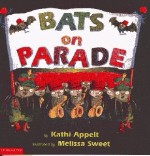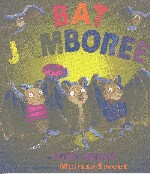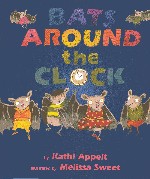- Multiplication Arrays: The book is a great introduction to multiplication arrays. Use the book illustrations to show students how to use an array to model a multiplication problem then ask students to create arrays for different multiplication facts.
- Class on Parade Book: Challenge students to design an array and a rhyme for an original page in theClass on Parade book. Decide on a theme and let pairs of students work on both the math and the language for a page.
Bat Jamboree by Kathi Appelt
- Student Written Problems: ask students to write original problems that use the triangular number pattern. Being able to write similar problems and solve them require higher-order thinking skills as students apply, synthesize and evaluate both the problems and the solutions.
Bats Around the Clock by Kathi Appelt
Take a humorous dance through time. Click Dark and American Batstand introduce a new dance each hour. Students move through time, enjoy some rhyme and learn the names of some oldie-but-goodie dances along the way.- Making Time: For the second reading, give students individual clocks and ask them to move the hour hand to the next hour and say the time before reading the book section for that hour.
- School Time: Provide copies of the
 School Time Template and have students choose a time in the school day, draw the hands on the clock, write a verse and draw an illustration that shows what the class does during that hour. Assemble the individual hours into a class booklet or booklets, depending on the number of students in the class. This activity is easily differentiated to feature time on the hour, or to use the real time schedule of activity changes the class follows. The template clock deliberately shows no hands, allowing teachers to customize the activity to the appropriate mathematical level of students in the class.
School Time Template and have students choose a time in the school day, draw the hands on the clock, write a verse and draw an illustration that shows what the class does during that hour. Assemble the individual hours into a class booklet or booklets, depending on the number of students in the class. This activity is easily differentiated to feature time on the hour, or to use the real time schedule of activity changes the class follows. The template clock deliberately shows no hands, allowing teachers to customize the activity to the appropriate mathematical level of students in the class.





Thanks so much for the book recommendations! I haven't seen these books before--I wish I would have seen "Bats on Parade" a few weeks ago at the beginning of my array unit! Good thing it is never to late to throw in a book :)
ReplyDeleteConsider yourself pinned. :D